


 
 
 
 Photo Essay: Okefenokee Swamp National Wildlife RefugeFirst posted in August, 2006 Photo Essay: Okefenokee Swamp National Wildlife RefugeFirst posted in August, 2006

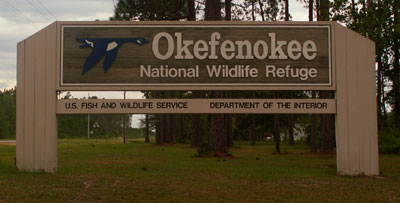 Welcome to Okefenokee National Wildlife Refuge.
This is what rangers call a "picture sign." Not because it has a picture on it,
but rather because everyone who visits stops to take a picture of it.
Welcome to Okefenokee National Wildlife Refuge.
This is what rangers call a "picture sign." Not because it has a picture on it,
but rather because everyone who visits stops to take a picture of it.
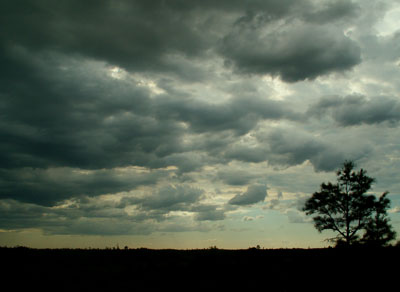 The word Okefenokee is an anglicized form of two Seminole words:
ecunnau, meaning earth, and finocau, meaning quivering.
The common translation of Okefenokee is Land of the Trembling Earth.
This isn't a reference to earthquakes.
The swamp is so perfused with water that the earth
is unstable and trembles at the slightest pressure.
The word Okefenokee is an anglicized form of two Seminole words:
ecunnau, meaning earth, and finocau, meaning quivering.
The common translation of Okefenokee is Land of the Trembling Earth.
This isn't a reference to earthquakes.
The swamp is so perfused with water that the earth
is unstable and trembles at the slightest pressure.
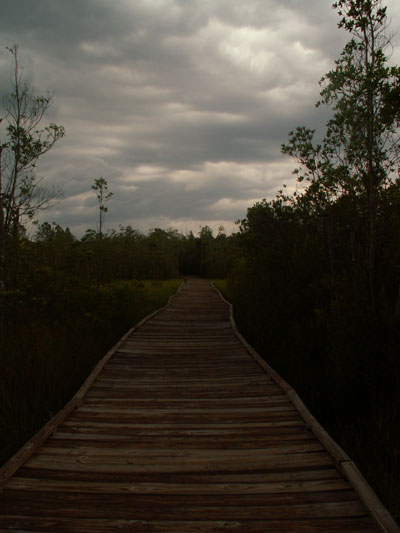 Such unstable ground, such incredibly swampy terrain,
makes for difficult travel. Though there are some solid
stretches of earthen trail in the refuge, a great deal of
travel is accomplished by one of two means:
boardwalk or boat.
Such unstable ground, such incredibly swampy terrain,
makes for difficult travel. Though there are some solid
stretches of earthen trail in the refuge, a great deal of
travel is accomplished by one of two means:
boardwalk or boat.
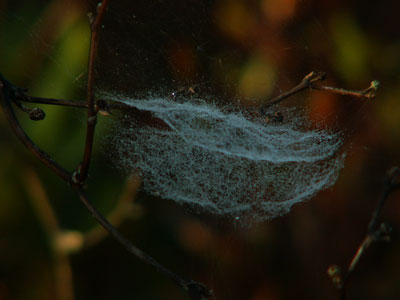 It's difficult to get great macro shots from a boat; walking the trails and
boardwalks allows for close examination of the landscape,
such as this double tiered spider web.
It's difficult to get great macro shots from a boat; walking the trails and
boardwalks allows for close examination of the landscape,
such as this double tiered spider web.
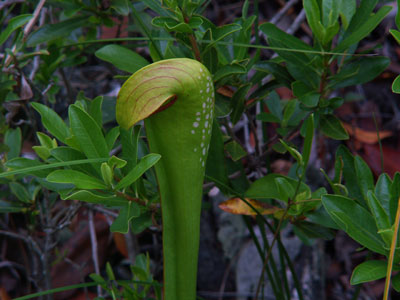 And carnivorous plants!
The Sarracenia genus has eight species, seven of which
are found only in the southeastern U.S.
Insects are attracted inside these plants by the odor of decay or
sweetness, and are forced downward by angled hairs inside the plant.
They are then trapped inside a small pool where a narcotic helps drown
them, and enzymes convert the protein into usable nitrogen.
And carnivorous plants!
The Sarracenia genus has eight species, seven of which
are found only in the southeastern U.S.
Insects are attracted inside these plants by the odor of decay or
sweetness, and are forced downward by angled hairs inside the plant.
They are then trapped inside a small pool where a narcotic helps drown
them, and enzymes convert the protein into usable nitrogen.
 There are also many anoles, Anolis carolinensis, which love to run along
the boardwalks. Locally, people refer to them as "swamp chameleons."
They really can change color, too.
There are also many anoles, Anolis carolinensis, which love to run along
the boardwalks. Locally, people refer to them as "swamp chameleons."
They really can change color, too.
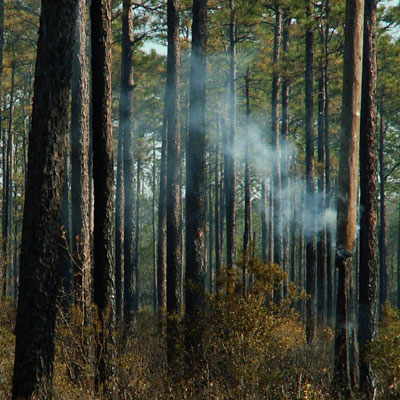 I made two visits to the swamp this year, once in February, once in June.
The first image of Okefenokee, for me, was of a world being reborn.
The cooler temperatures of February allowed for prescribed burns.
I made two visits to the swamp this year, once in February, once in June.
The first image of Okefenokee, for me, was of a world being reborn.
The cooler temperatures of February allowed for prescribed burns.
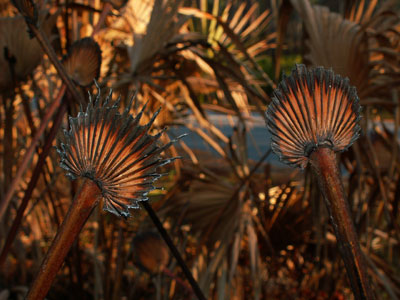 These fires thin the forest by more natural means than logging,
thus reducing fuel available for devastating fires during the heat of summer,
such as the fires of the mid 1950s that consumed 80% of the refuge.
These fires thin the forest by more natural means than logging,
thus reducing fuel available for devastating fires during the heat of summer,
such as the fires of the mid 1950s that consumed 80% of the refuge.
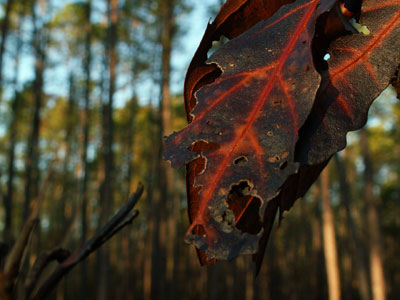 Fire has always been a part of the ecosystem, but as man moves into
areas he suppresses fire to protect timber resources and nearby property.
Prescribed burns allow for this natural process to occur in a controlled way.
Fire has always been a part of the ecosystem, but as man moves into
areas he suppresses fire to protect timber resources and nearby property.
Prescribed burns allow for this natural process to occur in a controlled way.
 Prescribed burns in the refuge help maintain the natural balance of
pine-dominant forests - pine seedlings require lots of sunlight to survive.
The fires destroy hardwood competitors, but the thick bark of the pine
resists fire damage. Species such as this Pileated Woodpecker need
mature, standing pines with soft centers as a place to make nests.
Prescribed burns in the refuge help maintain the natural balance of
pine-dominant forests - pine seedlings require lots of sunlight to survive.
The fires destroy hardwood competitors, but the thick bark of the pine
resists fire damage. Species such as this Pileated Woodpecker need
mature, standing pines with soft centers as a place to make nests.
 Okefenokee Swamp has more than natural history. You can learn about
the Seminole Indians, or visit the historic Chesser Homestead.
Okefenokee Swamp has more than natural history. You can learn about
the Seminole Indians, or visit the historic Chesser Homestead.
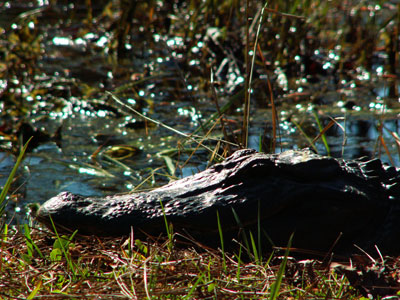 But of course most people travel to Okefenokee to view the alligators.
And they are everywhere. This one was sunning itself
a few feet from the visitor center. The low angle was
achieved by me lying on my stomach for the shot.
Don't worry - there was a fence and a zoom lens between us.
But of course most people travel to Okefenokee to view the alligators.
And they are everywhere. This one was sunning itself
a few feet from the visitor center. The low angle was
achieved by me lying on my stomach for the shot.
Don't worry - there was a fence and a zoom lens between us.
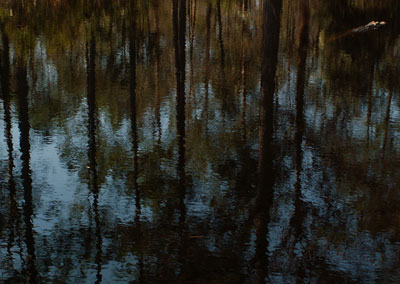 That alligator eventually decided to swim on down the canal.
That alligator eventually decided to swim on down the canal.
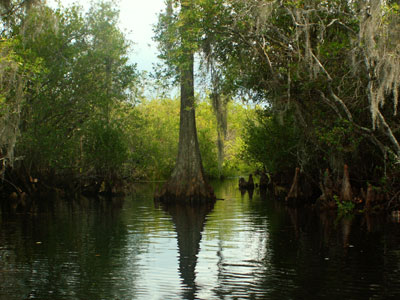 The best place to see alligators is in the cypress swamps,
a flooded landscape where they move with ease and grace.
The best place to see alligators is in the cypress swamps,
a flooded landscape where they move with ease and grace.
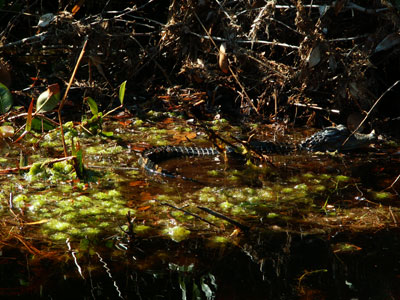 This requires either a canoe or a motorboat. On my first trip, in February,
my friend Glen and I rented a canoe. This was quiet, and pleasant, and
allowed you access to motor-free portions of the swamp.
I'm pretty certain I would never have captured this image of a baby
alligator had we been speeding past in a motorboat.
This requires either a canoe or a motorboat. On my first trip, in February,
my friend Glen and I rented a canoe. This was quiet, and pleasant, and
allowed you access to motor-free portions of the swamp.
I'm pretty certain I would never have captured this image of a baby
alligator had we been speeding past in a motorboat.
 But on the other hand, paddling speed doesn't allow
you to see nearly as much of the refuge.
But on the other hand, paddling speed doesn't allow
you to see nearly as much of the refuge.
 So, upon my return in June with Sam, we rented a motorboat.
This allowed us to get to places like Coffee Bay,
which on this day was free of people
(but unfortunately full of wasps).
So, upon my return in June with Sam, we rented a motorboat.
This allowed us to get to places like Coffee Bay,
which on this day was free of people
(but unfortunately full of wasps).
 Sam spent the time in Coffee Bay sketching, while I took photographs and
wrote an entry in my meditation journal (the first photo of this post).
Sam spent the time in Coffee Bay sketching, while I took photographs and
wrote an entry in my meditation journal (the first photo of this post).
 One thing the swamp is known for are insects.
Dragonflies, biting flies, mosquitoes.
One thing the swamp is known for are insects.
Dragonflies, biting flies, mosquitoes.
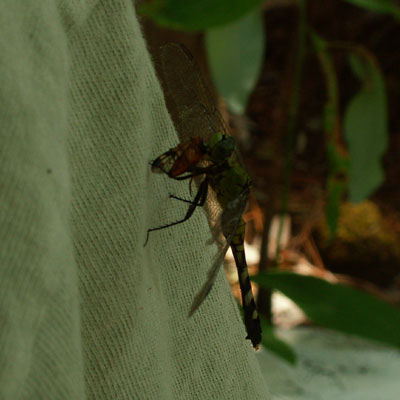 It was the yellow flies that bothered us most. I received a couple of
bites that tormented me until two or three weeks later. But the flies,
like everything else here, are part of the ecosystem.
Here, Sam and I delight in the death of a yellow fly.
Dinner is served on Sam's sleeve.
It was the yellow flies that bothered us most. I received a couple of
bites that tormented me until two or three weeks later. But the flies,
like everything else here, are part of the ecosystem.
Here, Sam and I delight in the death of a yellow fly.
Dinner is served on Sam's sleeve.
 The dragonflies weren't the only ones out hunting.
(Nephila clavipes, aka the Golden-silk Spider)
The dragonflies weren't the only ones out hunting.
(Nephila clavipes, aka the Golden-silk Spider)
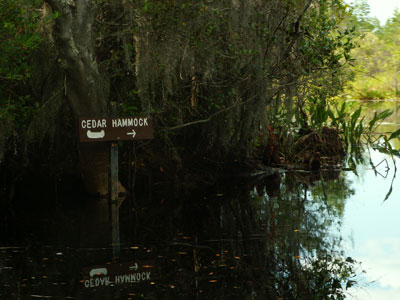 The swamp has a number of "trails," marked with signs.
I don't know why, but I just love the concept of boating
in much the same way one would normally go hiking.
The swamp has a number of "trails," marked with signs.
I don't know why, but I just love the concept of boating
in much the same way one would normally go hiking.
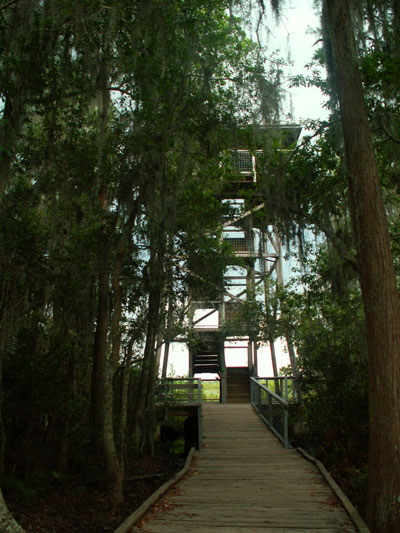 Still, I love how hiking brings you closer to the landscape.
There aren't any challenging hikes in the swamp - everything
is far too flat - but the refuge has many points of
interest, such as the Owl's Roost Tower.
Still, I love how hiking brings you closer to the landscape.
There aren't any challenging hikes in the swamp - everything
is far too flat - but the refuge has many points of
interest, such as the Owl's Roost Tower.
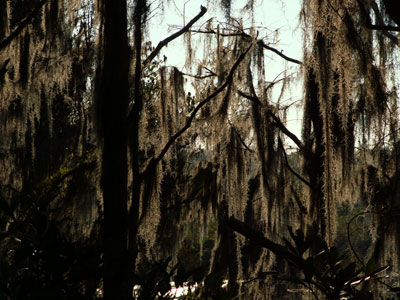 This places you fifty feet above the landscape, high in the tree
canopy, eye to eye with the Spanish moss.
This places you fifty feet above the landscape, high in the tree
canopy, eye to eye with the Spanish moss.
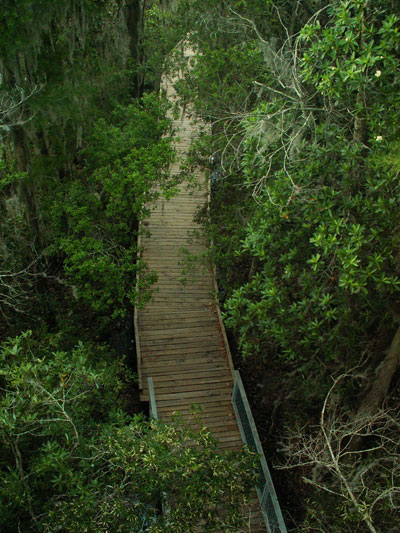 It also gives you a fantastic view of Seagrove Lake, Chesser Prairie...
...and the boardwalk, far below.
It also gives you a fantastic view of Seagrove Lake, Chesser Prairie...
...and the boardwalk, far below.
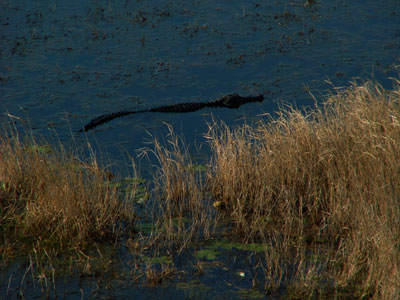 This photograph was taken in February, of the very first alligator
I ever saw in the wild. It was taken from the Owl's Roost in early
morning... an amazing, almost magical time. I will always remember
watching this ancient creature as it slid through the water,
listening to the birds and insects as the swamp began to
wake up - and warm up - for the day.
This photograph was taken in February, of the very first alligator
I ever saw in the wild. It was taken from the Owl's Roost in early
morning... an amazing, almost magical time. I will always remember
watching this ancient creature as it slid through the water,
listening to the birds and insects as the swamp began to
wake up - and warm up - for the day.
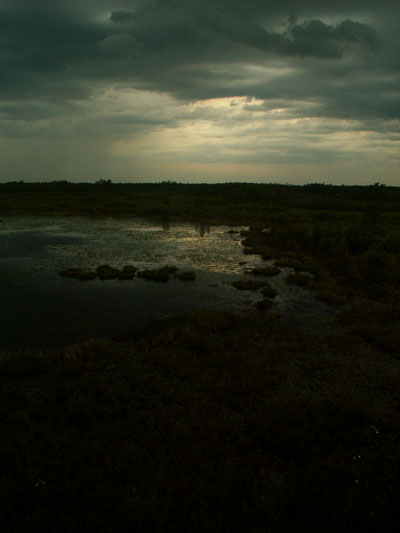 On the day that Sam and I visited,
there were no alligators in the lake below.
On the day that Sam and I visited,
there were no alligators in the lake below.
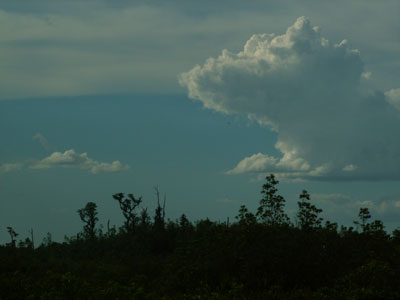 But amusingly enough, there was one up in the sky overhead.
But amusingly enough, there was one up in the sky overhead.
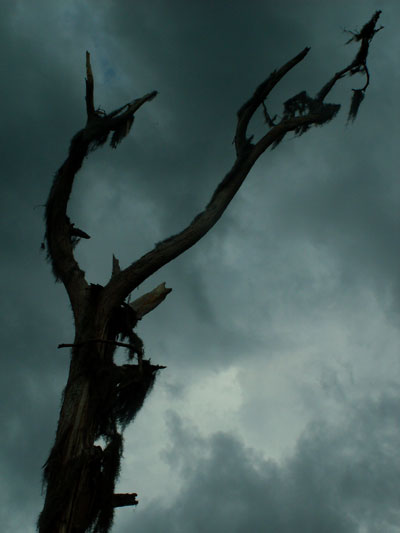 It was very late in the afternoon, though, and there was a storm coming.
These are the storms that bring the lightning and the fire.
And the refuge closes in the early evening anyway,
so it was time to go.
It was very late in the afternoon, though, and there was a storm coming.
These are the storms that bring the lightning and the fire.
And the refuge closes in the early evening anyway,
so it was time to go.
[ TOP OF THIS PAGE | MORE PHOTOGRAPHY | MORE WRITING | HOME ]


|









